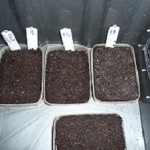Conventional Cricket Breeding Methods are best suited to medium or large scale commercial production
Adult crickets are highly carnivorous and will readily eat smaller crickets given the chance.
As a result conventional cricket breeding systems separate each cricket size (i.e. small, medium and large crickets) usually a week apart.
 There are variations to this method, but generally this is how it works:
There are variations to this method, but generally this is how it works:
- Small trays of soil/substrate are placed in a breeding container where the females lay their eggs (called breeding trays).
- The breeding trays are removed every 2-4 days and placed into an incubation chamber.
- After approximately 11-14 days at around 90-95 degrees Fahrenheit (32-35 degrees Celsius), the babies called pinheads hatch.
- Pinheads are collected daily for a week by tapping them to one end of the incubator chamber, and moved to a grow out container where they mature.
- It takes approximately 5 weeks for crickets to reach adult, so 5 grow out containers are required, one for each week. Consequently you need 7 individual containers in total to complete the full life cycle; one breeding container, one incubation chamber and five grow out containers.
- No substrate is placed on the floor of the breeding container as you have the breeding trays for egg laying.
Now all this is good and well, but after a few months most people find these techniques too messy, smelly and time consuming just to feeding a few bearded dragons.
This is why it is better suited to medium and large scale production where the larger quantities of crickets justifies the active management required. At Wildlife Hub we learnt this first hand, and knew we would need to develop new and more efficient methods if we were going to continue with our research, wildlife rescue and reptile keeping.
As a result of these difficulties we spent over a decade streamlining both commercial and private methods.
Click here to learn how to breed crickets with our private or small scale commercial breeding method.

 There are variations to this method, but generally this is how it works:
There are variations to this method, but generally this is how it works: